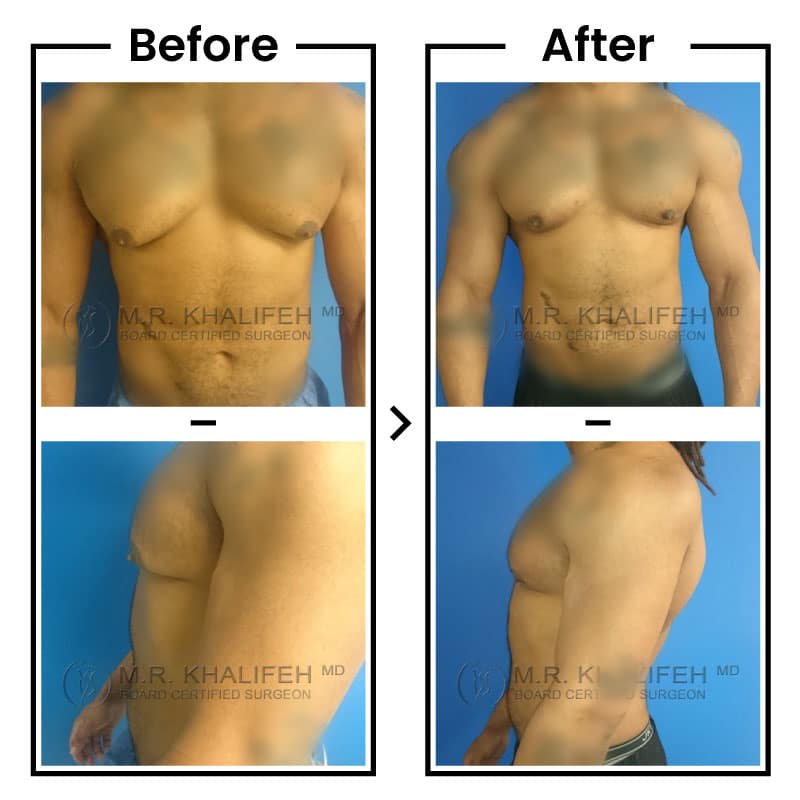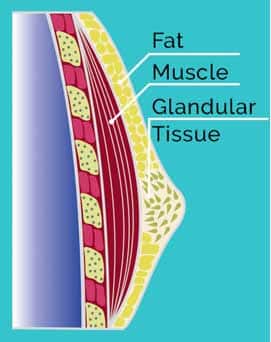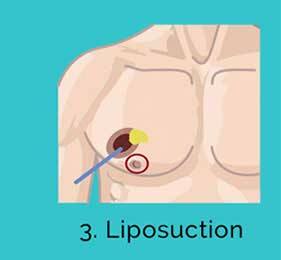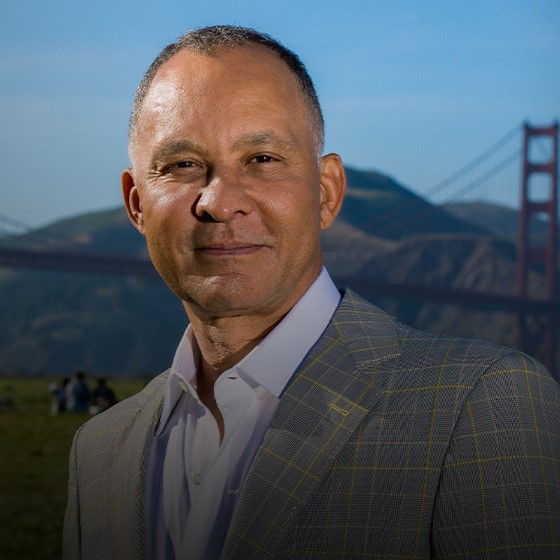What is Gynecomastia?
Gynecomastia is male breast enlargement when the breast gland tissue swells. Gynecomastia is caused when the male estrogen level is too high in relation to the testosterone level. The hormonal balance is tipped to the development of a female-like breast on a man. Gynecomastia can affect one or both breasts.
What Causes Gynecomastia Breast Gland Tissue?
Gynecomastia is caused by an imbalance between the male hormone testosterone and estrogen that controls female traits. Testosterone causes the development of male traits like body hair and muscle mass. Estrogen controls female characteristics like breast development. However, both sexes have an amount of the opposite hormone. When the balance of these hormones is “off,” different sex characteristics can develop. In the case of men, when the male estrogen level is too elevated or out of balance with testosterone levels, then Gynecomastia, aka man boobs, can develop.
Gynecomastia develops three times in a male’s life.
These time frames are when gynecomastia develops:
- Immediately after birth. Newborn males are still carrying extra estrogen from their mothers during development. Over fifty percent of males are born with enlarging breasts; however, this usually resolves in a few weeks after birth.
- During puberty or pubertal gynecomastia. Estrogen and testosterone levels change drastically during puberty. This occurs during 12-14 years of age. As much as 70 percent of young men develop Gynecomastia during this time. But, the male breast enlargement usually goes away between 6 months and two years. In about 25% of males, gynecomastia does not resolve completely.
- Midlife. Male breast enlargement usually peaks in men between the age of 50 and 80 years of age. Gynecomastia is due to the drop in testosterone levels, aka “low-T.” At this age. Over 65 percent of men are affected. During this time, breast cancer can develop at a rate of less than 1 percent.
There are other less common causes of Gynecomastia, but to mention, the most common are:
- Pseudogynecomastia or “fake gynecomastia” is due to being overweight, and weight loss can dramatically help this condition. The enlarged male breasts are due to fatty tissue and not glandular tissue.
- Drug-induced gynecomastia caused by anabolic steroids to enhance athletic performance. Gynecomastia caused by anabolic steroids is the second most common cause.
- Medications like Finasteride for enlarged prostate/prostate cancer or hair loss, to name a few.
- Medical conditions like tumors in the adrenal glands or testicles, liver disease, or hypogonadism, to name a few.
How is Gynecomastia Diagnosed?
The diagnosis of Gynecomastia is based on physical examination, physical symptoms, medical history, and medication review.
Gynecomastia symptoms include breast(s) that may be painful with tenderness and often have a disc shape rubbery tissue that can be easily felt. This tissue is located directly underneath the nipple and mobile within the breast tissue.
Your physician will evaluate your medical history to determine the cause of the Gynecomastia. He will review your supplements, medications, and herbal products. Your doctor will also review your medical history and order the appropriate blood tests to determine if other diseases or medical conditions are the cause of your Gynecomastia.
There are a variety of breast imaging tests that may be used, a mammogram or breast ultrasound to evaluate male breast tissue. These tests are usually ordered to evaluate breast cancer. Your physician may order a blood test like a hormone panel to check for any hormonal changes.
What Is The Treatment for Gynecomastia Breast Tissue?
Treatment for enlarged breasts in men is recommended when there is breast tenderness and discomfort or an aesthetic or cosmetic issue. If a medical illness is causing Gynecomastia, a prescribed medication may need to be given. Gynecomastia usually affects both breasts but can affect one or both breasts.
At times, medicine is the cause, and your physician may advise stopping the drug and changing to another. Your doctor may advise going to an endocrinologist( a physician who specializes in hormone-related issues).
Surgery is recommended for patients with severe pain and tenderness or embarrassment. Male breast reduction surgery or gynecomastia surgery is the surgical treatment of choice for breast tissue removal.
Counseling may be needed for men and boys who find it hard to cope with this medical condition. Gynecomastia can be embarrassing, resulting in shame and avoidance of social situations requiring a bare chest( swimming, public shower, locker room, etc.). This can cause a tremendous amount of stress and depression. Discussing this situation with a professional may be helpful.
Other conditions may look like Gynecomastia but are not true Gynecomastia. A few of the most common are listed below.
- Male breast cancer. Cancer of the breast in men is uncommon and occurs in less than 1% of men. It usually affects one breast. The breast is usually no breast pain, and a firm lump may be present which feels attached to the surrounding tissue. The overlying skin may appear indented or dimpled and possible nipple discharge. The lymph nodes may be enlarged.
- Fatty breast tissue or pseudogynecomastia. This is common in overweight men. It is due to fat accumulation in the chest. Gynecomastia is due to breast gland development and not fat.
Male breast reduction surgery is the definitive treatment for gynecomastia. It removes the breast glands permanently.
FAQ’s
Can Gynecomastia Go Away on its Own?
In medical terms, gynecomastia refers to enlarged breasts in men. Teenagers going through the puberty process are likely to experience this condition.
Generally speaking, it will disappear on its own by the age of 21 for most young males, and most often two years after it first develops.
Gynecomastia rarely goes away by itself in adult males, no matter how hard they work, how much they exercise, and how much they diet.
Gynecomastia is primarily caused by hormonal imbalance, steroids, marijuana use, and certain prescription medications. One or both breasts may be affected by gynecomastia, and the condition can be uneven. Gynecomastia is a condition that leaves adult men feeling helpless about their condition.
Gynecomastia is curable. In the majority of cases, enlarged breasts in adolescent boys will disappear once they reach adulthood. Exercise and weight loss may be helpful for men with fatty gynecomastia. Typically, gynecomastia is caused by an excess of fibrous breast tissue that cannot be removed by DIY methods.
With male breast reduction surgery, this form of gynecomastia will be removed permanently and completely. A board-certified plastic surgeon with extensive experience in treating gynecomastia should be sought for gynecomastia surgery. Surgery performed by an unqualified surgeon is often associated with high rates of dissatisfaction. Usually, they rely solely on liposuction. Breast tissue will not be removed with this technique.
How Do You Differentiate Between Gynecomastia and Male Breast Cancer?
Among the most important characteristics that differentiate a male with breast cancer from a male with gynecomastia is symmetry. In men with gynecomastia, for example, both breasts are nearly always swollen. In contrast, men who have breast cancer usually find a lump or swelling only in one breast. Also, breast malignancy may show skin changes like skin dimpling or contraction.
What is The Best Treatment for Gynecomastia?
The following are two options to treat gynecomastia with surgery:
- Surgical liposuction. In this surgical procedure, fatty tissue is removed from the breast but not the glandular tissue. This is best used for psueudogynecomastia which is gynecomastia due to excessive fat deposits.
- The procedure of mastectomy. The enlarged breast tissue is removed in this procedure. In many cases, only small incisions are needed for the surgery. There is a shorter recovery period following this less invasive type of surgery.
How Can I Reduce Gynecomastia?
To treat gynecomastia effectively for an immediate and permanent solution to the problem of excess breast tissue and fat gynecomastia surgery or male breast reduction surgery is the solution.
These are some of the more popular methods to reduce gynecomastia:
- Weight loss.
- Exercise and dieting are essential.
- Avoiding the use of steroids or drugs.
- Taking steps to reduce alcohol consumption.
- Receiving hormone treatments.




